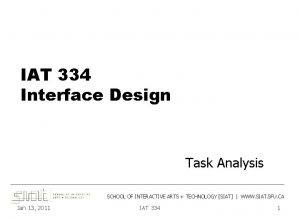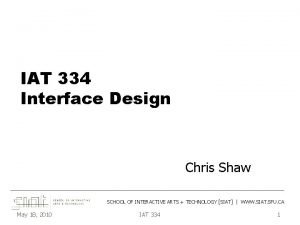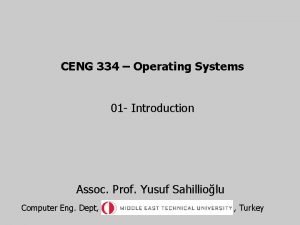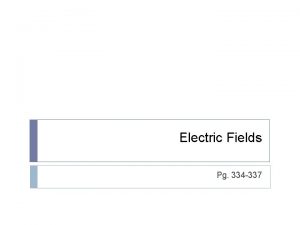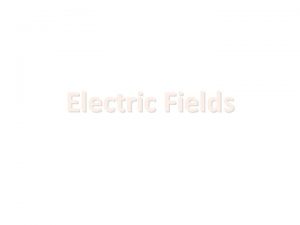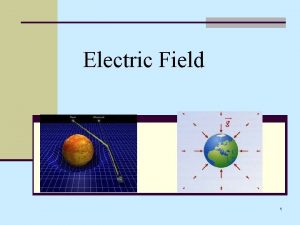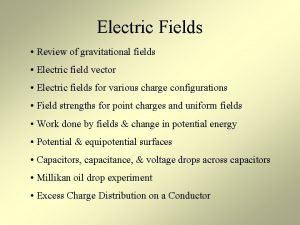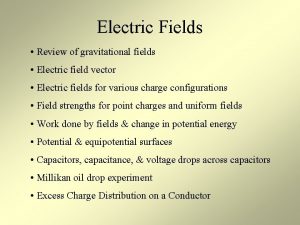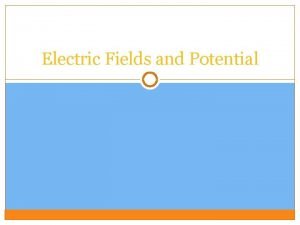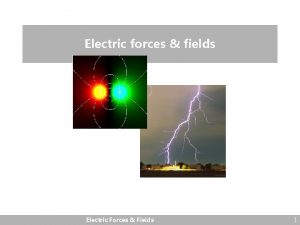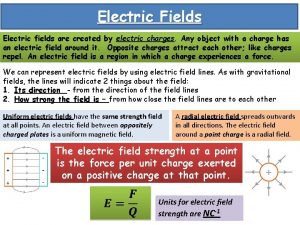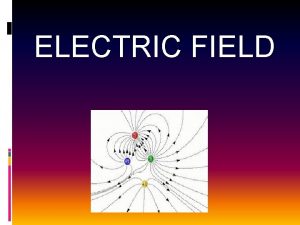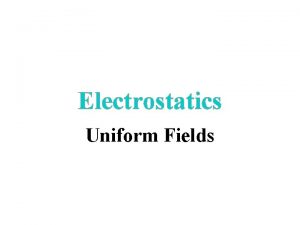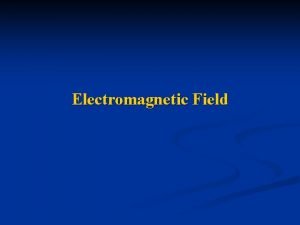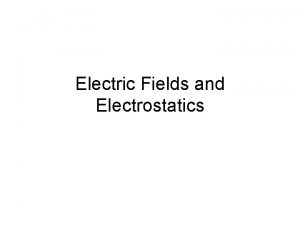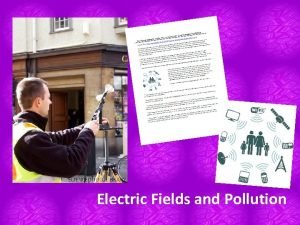Electric Fields Pg 334 337 Electric Fields Field
















- Slides: 16

Electric Fields Pg. 334 -337

Electric Fields � Field of force that exists in a region of space around a charged object � Is a vector quantity � Exerts attractive/repulsive force on other charged objects

Electric Fields � For example, the diagram illustrates the generation of an electric field, by a charge, q 1 � The density of the shading designates the strength of the field � If a second positive charge, q, is introduced into the field at point P, it is the field that interacts with q to produce the electric force � Note: if q 1 were negative, the electric field and force would be in the opposite direction

Electric Fields � The describe the field around a charge, q, it is convenient to use the concept of a positive test charge � By definition, a test charge, q. T, is a point charge with a magnitude so much smaller than the source charge that any field generated by the test charge itself is negligible in relation to the field generated by the source charge. � In this case:

� Take note…. � Electric fields point away from positive charges (a) and toward negative charges (b) � This convention is based on using a positive test charge to determine direction

Electric Field Intensity

Practice � 1. A positive test charge, q. T = +2. 0 x 10 -9 C, is placed in an electric field and experiences a force of 4. 0 x 10 -9 N[W] � a) what is the electric field intensity at the location of the test charge? (2. 0 N/C [W]) � b) predict the force that would result if the test charge were replaced by a charge of q. T = +9. 0 x 10 -6 C.

Electric Field Intensity � When more than one electric source charge is present, the electric field vector at any point is the vector sum of the electric fields attributable to each source charge considered separately � Since the field lines are often curved, this vector will be tangent to the field line at that point

Practice � 2. Two point charges (q 1 = +3. 3 x 10 -9 C and q 2 = 1. 0 x 10 -8 C) are located 45 cm apart. � a) a positive test charge is located between q 1 and q 2 and 27 cm from q 1 along a line connecting q 1 and q 2. What is the net electric field intensity on the positive test charge? � b) a new charge of +2. 0 x 10 -12 C is placed at P. Determine the electric force on this new charge. � 3. In the diagram, A and C are situated as shown. What is the magnitude and direction of the electric field intensity at point B?

Applications of …. – Earth’s Electric Field � Energy from the Sun bombards Earth’s upper atmosphere � Some of this energy strips electrons from atoms, leaving a region of positively charged ions and free electrons – the ionosphere � In contrast to the ionosphere, Earth’s surface is more negatively charged � Both areas tend to stay charged, so that a permanent electric field exists throughout the atmosphere

Application of … - Earth’s Electric Field � One device, called an electric field mill, or just a field mill, is widely used to measure Earth’s electric field � A field mill makes use of the uniform electric field between two parallel conducting plates and detects changes in the field strength at a given location.

Application of. . – Electrostatic Precipitator � During the Industrial Age, heavily polluted air resulted from the smoke pouring out of chimneys and smokestacks � Most of these emissions, called flue gases because they passed through the flues of chimneys, consisted of clear gases such as nitrogen and carbon dioxide � However, tiny particles of carbon, sulfur compounds and dust produced by various chemical processes combined with the gases to give the air its smoky appearance

Applications of …- Electrostatic Precipitator � Today, industrial processes continue to pollute our air � In recent years, though, devices called electrostatic precipitators have reduced the number of particles released into the atmosphere � Electrostatic precipitators use electric fields to remove extremely small particles of soot, dust, and ash from the flue gases and other emissions produced by combustion, smelting and refining.

Application of… - Electric Fields in Nature � Electric fields are also produced by animals � These fields are often weak and produced by ordinary actions, such as motion in the muscles � Some animals have organs that detect and respond to these weak electric fields � Hammerhead sharks, for example, detect fields as long as 6 N/C in fish that hide beneath the sand or in tunnelled shelters along ocean bottoms

Applications of Electric Fields � X-ray machines, LCD displays, telephones, particle accelerators, … � Electrostatic precipitators remove extremely small particles of soot, dust and ash from flue gases � Some organisms can detect the weak electric fields of other organisms � Medical instruments such as a Theremin http: //www. ted. com/talks/bill_doyle_treating_cancer_with_electric_field

� Textbook: � Pg. 337, #2, 3 � Practice quiz?
 Magnetic field
Magnetic field 21lwuy8i6hw -site:youtube.com
21lwuy8i6hw -site:youtube.com Q factor of capacitor
Q factor of capacitor K constant unit
K constant unit Electric potential from electric field
Electric potential from electric field Units of a charge
Units of a charge Energy in an electric field
Energy in an electric field Chapter 21 electric charge and electric field
Chapter 21 electric charge and electric field What is electric potential
What is electric potential Chapter 21 electric charge and electric field
Chapter 21 electric charge and electric field Electric potential energy
Electric potential energy Red fields to green fields
Red fields to green fields Love story 334
Love story 334 Iat 334
Iat 334 Iat 334
Iat 334 Iat 334
Iat 334 Ceng 334
Ceng 334













